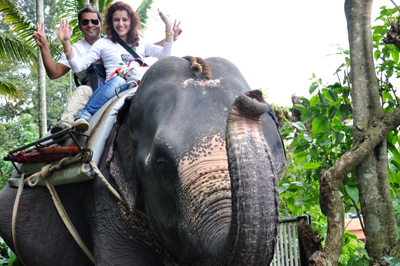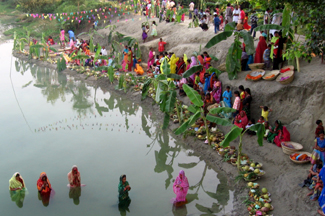By Sona Avagyan
 Indians say that whenever foreigners come to India, they experience two shocks.
Indians say that whenever foreigners come to India, they experience two shocks.
 Rananjay
says that whatever he was trying to do in Armenia, people responded
positively. He pleasantly recalls an incident that happened when they
were having a picnic at Geghard Monastery. An old man was crossing the
river carrying 10-12 bottles of water. Rananjay held some bottles to
help him. When Rananjay gave all the bottles back, the old man gave one
to Rananjay and said: “Please leave it, this is a sunny day and you may
feel thirsty later. You are our guest and we would love to see you
well.”
Rananjay
says that whatever he was trying to do in Armenia, people responded
positively. He pleasantly recalls an incident that happened when they
were having a picnic at Geghard Monastery. An old man was crossing the
river carrying 10-12 bottles of water. Rananjay held some bottles to
help him. When Rananjay gave all the bottles back, the old man gave one
to Rananjay and said: “Please leave it, this is a sunny day and you may
feel thirsty later. You are our guest and we would love to see you
well.”
 Ruzanna
Ashughyan Anand says that the number of Armenians now living in
Calcutta has dwindled to a handful from centuries past. In Calcutta
Armenian life revolves around the Armenian Church. But in Delhi one can
meet students and tourists from Armenia, as well as newly established
Indo-Armenian families in which the wives are mainly Armenian. The IAF
tries to facilitate connections amongst the Armenians of India. In 2011,
the NGO celebrated Armenia’s Independence Day in India on a small
scale.
Ruzanna
Ashughyan Anand says that the number of Armenians now living in
Calcutta has dwindled to a handful from centuries past. In Calcutta
Armenian life revolves around the Armenian Church. But in Delhi one can
meet students and tourists from Armenia, as well as newly established
Indo-Armenian families in which the wives are mainly Armenian. The IAF
tries to facilitate connections amongst the Armenians of India. In 2011,
the NGO celebrated Armenia’s Independence Day in India on a small
scale.
 Indians say that whenever foreigners come to India, they experience two shocks.
Indians say that whenever foreigners come to India, they experience two shocks.
First is the cultural shock, because India is completely chaotic, and
you need to realize yourself by your own definition in that ocean. But
once foreigners start living in India and explore it, they are
completely subsumed in the country. The second shock is when they have
to return to their countries, but don’t want to, even if they don’t know
the reason why they have become so attached to India.
But Armenian theologist Ruzanna Ashughyan had different feelings when
leaving India in 2011 after having studied in Delhi for 2 months,
because she knew she would return for permanent residence.
In 2012, Yerevan-based Ruzanna Ashughyan married Delhi-based Indian
businessmen Rananjay Anand. After studying German at Jawaharlal Nehru
University in Delhi, he went on to complete his MBA. They had had a
chance meeting back in 2009 on a social networking website.
Rananjay, like many other Indians, had never heard about Armenia. He
even thought Armenia might be a city in another country. Ruzanna, like
many other Armenians, was not knowledgeable about modern-day India.
Rananjay was amazed when Ruzanna asked him if people were very poor in
India.
“So we started discussing each other’s country, people, philosophy,
culture, religion, everything, because it was all new to us. During that
time we came to know that there was a very special relationship between
India and Armenia which lost its former brilliance in the course of
time,” Rananjay says.
When Rananjay Anand came to Armenia for the first time in 2011, he and Ruzanna Ashughyan had already decided to get married.
Rananjay will never forget hospitality of old man at Geghard
“I cannot forget this my lifetime and I am deeply in love with
Armenia. That gave me a great impression of a counrty and I always tell
this story to my friends in India, about the great hospitality and
people we have in Armenia,” Rananjay says.
As for Ruzanna, when she first went to India she was surprised seeing
so much diversity, so much population. On the other hand, she was
surprised at seeing so much development in the country she thought to be
under-developed.
India is one of the world’s largest and fastest growing economies. At
the same time, India is a country of coexistence and paradox. In
Rananjay’s words, you have very posh buildings and five star hotels in
India, but poverty is a stone’s throw away. You have very well organized
infrastructure in India, where the rich and poor walk side by side.
“In India you can find everything. We went to Kashmir in June.
Kashmir is in Himalayan Mountains. When I was in the forested mountains,
I felt as if I was in Dilijan or Ijevan. Later on, I visited the south.
And that was totally different experience. I was amazed that this is
the same India,” Ruzanna Ashughyan Anand says.
Rananjay also cannot say that he knows the whole of India. “It’s a
huge country. India is an ocean and living in India is like living in an
ocean. An entire life is not enough to explore India,” he says.
Whenever Rananjay Anand is in Armenia he tries to explore Armenia as
well. He has been to Khor Virap, Garni, Etchmiadzin and Tsakhkadzor.
Now, he and Ruzanna plan to visit Dilijan, Ijevan and Artsakh.
Rananjay plans to learn Armenian completely and Ruzanna plans to learn Hindi completely
The couple has been living in Delhi for eight months now. They
celebrated New Years in Armenia. At their wedding in Yerevan last year,
the entire tiny Indian community of Armenia was present. Achal Kumar
Malhotra, then the Ambassador of India to Armenia, and his wife gladly
agreed to step in to take the place of Rananjay’s parents. Given the
short notice, no one from Rananjay’s family managed to come to Yerevan
for the wedding.
When asked about what they do to benefit from their different
national identities, cultures and lifestyles, rather than letting them
hinder their life, Rananjay responds that it’s all about giving space
and respect to each other.
“Marriage is something that is dependent not only upon culture. Any
marriage can be successful or unsuccessful anywhere in the world,
whether it is an Indian or an Armenian marriage. Once you understand
each other, it’s not a problem. We always share our difficulties and
challenges,” Rananjay says. Ruzanna adds that without the support of
one’s partner, it’s near impossible to survive when faced with a new set
of circumstances outside one’s native country.
Rananjay's parents live in Bihar state, quite a distance from Delhi.
Whenever “Diwali” and “Chhath” are celebrated, Rananjay and Ruzanna
visit his parents. “Diwali”, the festival of lights, is celebrated six
days before “Chhath”, the worship of the sun, the main and most sacred
festival in Bihar. There is a tradition in India to celebrate these
festivals with families.
 |
 |
| “Chhath" festival | “Diwali” festival, photos from wikipedia.org |
Rananjay and Ruzanna generally speak English to each other and
sometimes Hindi, the official language of India. After settling in
India, she started learning Hindi, because Rananjay’s family always ask
Ruzanna to communicate with them in their mother language. In turn,
Rananjay is learning Armenian because Ruzanna’s family wants to
communicate with Rananjay without a translator.
“Our plan is that I will learn Armenian completely and she will learn
Hindi completely because this is the main communication hardship
between our families,” Rananjay Anand says.
Indo-Armenian Friendship NGO, founded by Rananjay and Ruzanna, operates both in Armenia and India
In 2009, after getting acquainted with Ruzanna, Rananjay started the India-Armenia Friendship Group
on Facebook to promote mutual awareness of each. The Facebook group now
has approximately 2,000 members from Armenia and India, as well as some
from other countries who just want to know more about Armenia and
India.
In 2011, Rananjay and Ruzanna founded the Indo-Armenian Friendship NGO
(IAF) and registered it in Armenia. The NGO’s core team is up of twenty
people who carry out the group’s projects. From the very start, then
Ambassador of India Achal Kumar Malhotra helped IAF with his advice and
encouragement.
The Indian community in Armenia is also very small, consisting of
mainly students at Yerevan State Medical University, Indian Embassy
employees, and a tiny business comminity. IAF is in close communication
with the Indian students of medical university and alumni who have
returned to Delhi. The Indian students in Armenia celebrate “Diwali”
every year. In November 2010 they celebrated “Diwali” with the support
of the India-Armenia Friendship Facebook Group. Rananjay hopes that if
everything goes well, “Diwali” in Yerevan will be celebrated not only
mainly among Indian students, but that more Armenians could come and
enjoy the festival.
At India’s top institution, Jawaharlal Nehru University International
Food Festival is organized every year on Republic Day of India. It is
the responsibility of the students from a particular country to come
together, prepare food representing their country and sell it at their
stall. Three students from Armenia study at Jawaharlal Nehru University.
In 2011, they organized Armenian Food Taste, displaying lavash, tolma and matsnabrdosh.
Rananjay says they supported the effort to make people more aware that
there is an Armenian stall. In his words, all the Armenia food was sold.
In January 2012 the group photo exhibition “India through the Armenian Lens”
dedicated to the 63th anniversary of the Republic Day of India was
organized in Yerevan. Rananjay organized the exhibition from India and
Ruzanna organized it in Armenia with the support of the Embassy of
India. At the opening ceremony, the Indian students performed the Indian
national dance “Bharatanatyam.”
More than 50 photos were exhibited. They were taken by Armenians who
had visited the new India and just clicked away with their cameras; they
were far from professional photographers. Two photos taken by Liz Chater,
a UK-based family history researcher specializing in Armenians in India
and an India-Armenia Friendship Facebook group member, were also
exhibited. Initially the exhibition was to last three days, but people
responded so warmly that IAF extended it to ten days.
| Holy Virgin Mary Armenian Church, Saidabad | Edward the VII Arch, Calcutta, “India through the Armenian Lens” exhibition, photos by Liz Chater |
The IAF’s last program was in Delhi in December 2012, when the NGO
organized an interactive session between Dr. T. Suresh Babu, the newly
appointed Ambassador of India to Armenia, and members of the IAF. Former
Ambassador Malhotra was also invited. The newly appointed ambassador
has yet to arrive in Armenia.
The IAF wants to take cultural troupes from Armenia to India in order
to organize Armenian cultural events there. The most challenging thing
for the NGO is to fund these programs. So far IAF has been funding these
programs itself, with the support of the Embassy of India in Armenia.
“We just want the two countries to come closer together, to the
extent possible. Once we succeed, it will change many things. We’re not
so big an organization that we can do it all on our own. Without the
support of others and our governments, we cannot realize our vision. But
we should always try instead of sitting back and doing nothing,”
Rananjay and Ruzanna say.
In Rananjay’s words, person to person contact has been the biggest
achievement of IAF since its establishment. He is sure that connecting
people and educating them about each other’s countries, even at a very
basic level, is very important work.
No comments:
Post a Comment